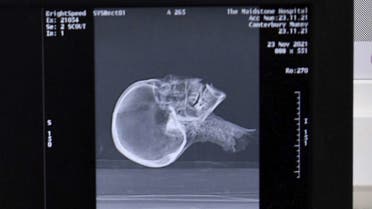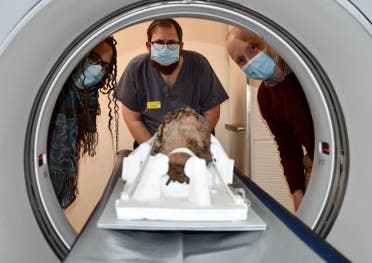
A decapitated Egyptian mummy’s head discovered in an attic in the British county of Kent has undergone a state-of-the-art CT scan to try and uncover its origins. (Supplied)
Jennifer Bell, Al Arabiya English
Published: 23 July ,2022
A decapitated Egyptian mummy’s head discovered in an attic in the British county of Kent has undergone a state-of-the-art CT scan to try and uncover its origins.
The head, which is at least 2,000 years old, was thought to have been brought to the UK from Egypt as a souvenir in the 19th century and given to the owner in the early 20th century.
For all the latest headlines follow our Google News channel online or via the app.
It was discovered in a glass case during a clear-out after the death of a man in the British area of Ramsgate.
Researchers say the head, minus its body and any wrappings was inherited by the man’s brother, who took it to the Canterbury Museums and Galleries for examination.
Initial X-rays at Canterbury Christ Church University suggested that it was an adult woman, however, the team organized a detailed CT scan to learn more about the long-dead individual.

The mummy head undergoing a CT scan at Maidstone Hospital. (Supplied)
Preliminary results from the scan, carried out at Maidstone Hospital, indicate that the brain has been removed, the teeth are worn down by a rough diet, and the tongue actually shows incredible preservation.
The team is hoping to eventually recreate the face of the mysterious mummy and reconstruct the hidden history of this Egyptian.
“The scan provides a huge amount of information – everything from dental status, pathologies, method of preservation as well as assisting estimations of age and sex,” said James Elliott, a senior radiographer at Maidstone and Tunbridge Wells NHS Trust, in a media release. “We plan on using the scanning data to create a three-dimensional replica of the head and possible facial reconstruction to allow a more intensive study of it without exposing the actual artifact,”
Elliot explained how mummification was ‘common practice’ within ancient Egypt but with the advancement of CT technology, more detail can be researched on ancient Egyptian traditions.
“Beginning in 3500 BC, mummification was a way to safeguard the spirit in its journey to the afterlife.
“Mummification was common practice within ancient Egypt for both commoners and royalty, although with different levels of complexity and accompanying wealth.
“Ironically, the ancient Egyptians believed that a person's mind was held in their heart and had little regard for the brain. Regardless of this, the brain was removed to help the preservation of the individual. Although traditional accounts state the brain was removed exclusively through the nose, research using CT scans has shown great variability. Until relatively recently, the historic accounts have been accepted as gospel but the scanning of Egyptian mummies has challenged these ideas.”
Craig Bowen, Canterbury Museums and Galleries Collections and Learning Manager, added: “This project is part of a larger aim to preserve the head and allow it to be displayed in conservation grade packaging for public viewing.
“The conservation process also allows volunteers to experience and take part in important discussions surrounding the preservation, recording and study of human remains.”
The head is being preserved by professional archaeological conservator Dana Goodburn-Brown ACR, who is also coordinating the research efforts. As part of a collaborative scientific investigation of the head, experts from Canterbury Christ Church University, University of Kent and University of Oxford, will attempt to reconstruct the history of the individual.
The group hopes to present the findings to the public at the Beaney Museum in Canterbury.
No comments:
Post a Comment